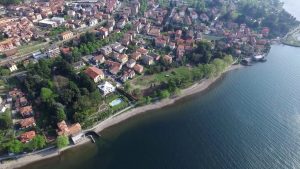
Italy is well known for its love of history and respect for historic architectural, painting and sculpture monuments. The Lake Como area, with its many small towns is no exception, and the village of Dervio, too, has managed to preserve some important examples to this day.
Dervio is located on a peninsula on the eastern shore of Lake Como, at the mouth of river Varrone and dominated by Monte Legnoncino. The name is of Celtic origin, meaning “oak tree”.
On this small peninsula, the climate is ideally and unusually mild: fresh breezes called Breva and Tivano make this area particularly attractive for water sports such as sailing and windsurfing. In fact, Devio boasts of three high level and well known sailing schools.
Devio was initially occupied by the Celts, then by the Romans who, in the 2nd and 3rd centuries, contributed to the development of the area, building several forts to help protect the settlements. In the glorious period between the 5th and 6th centuries several castles were also constructed – Castelvedro, Vezio and Esino. After the fall of the Roman Empire, it was then the turn of the Goths, the Longobards and the Francs. From the year 1000, Dervio was a theater for many battles, until the years between 1384 and 1389 when the Statute of Dervio was signed. The successive period of Spanish dominion is remembered for its violence, robberies and illness, whereas the arrival of the Austrians marked the beginning of a period of prosperity. Today, Dervio is a tourist and industrial center.
The centuries-old architectural patrimony of Dervio is impressive: there are churches, castles, historical buildings and monuments. For example, dominating the peninsula is the Castle of Orezia, which was part of a network of communication among the various forts that ringed the lake. The castle was built during the Middle Ages and unfortunately only its tower and the ruins of its medieval walls are still standing today. Along the ancient path that leads to Dervio from Como is the church of San Leonardo, owned by the noble Paruzzi family, with beautiful frescoes from the 15th century.
Another interesting site are the ruins of the Castelvedro castle, dating back to the 5th century and situated at 500m above sea level in the hamlet of Mai. With its 1500 square meters of grounds, the castle protected the road connecting Dervio with the strategic valley passage of Piazzo di Casargo.
Several churches are also particularly interesting. The 11th century Romanesque church of San Pietro and Paolo, right by the lake, was built on the ruins of an original church from the 6th century. Its altar has 12th century paintings by the Cavagnas, famous artists from Bergamo. Equally important is the church of SS. Quirico and Giuditta, built in 814 and considered a national patrimony for its elegant bell tower from the 11th century, still perfectly preserved.
In addition to castles and churches, special mentions are deserved by the ancient tomb “Archi Sarcofaghi Adriani,” and the home of the noble Magni family.
The location of the Dervio peninsula is particularly appreciated by water sports and boating lovers, as well as by mountain climbers and researchers of history.
In addition, walkers and hikers will enjoy the three-kilometer path along the lake, surrounded by a nature of rare beauty.
